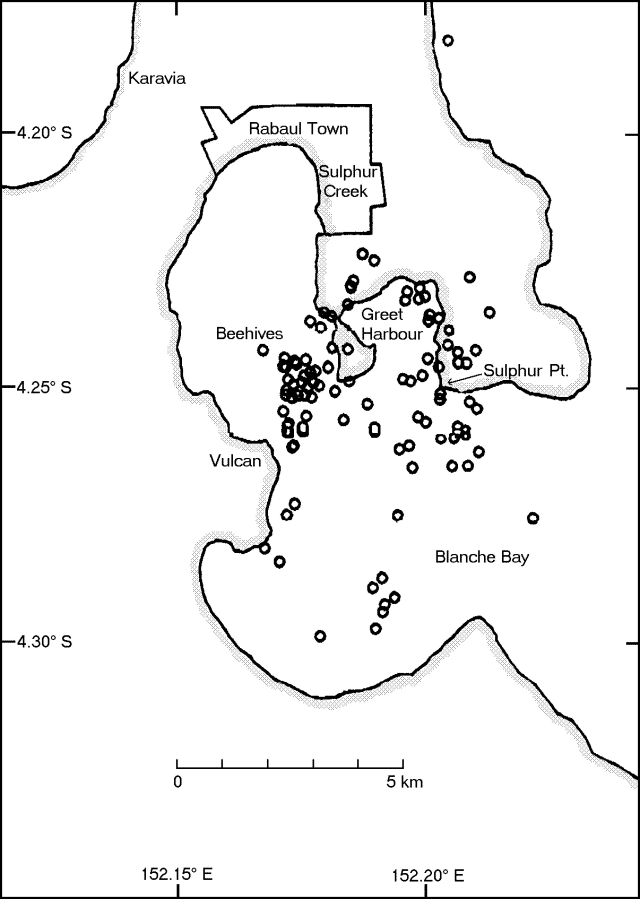Report on Rabaul (Papua New Guinea) — January 1990
Bulletin of the Global Volcanism Network, vol. 15, no. 1 (January 1990)
Managing Editor: Lindsay McClelland.
Rabaul (Papua New Guinea) Seismicity and deformation decline; unrest since October summarized
Please cite this report as:
Global Volcanism Program, 1990. Report on Rabaul (Papua New Guinea) (McClelland, L., ed.). Bulletin of the Global Volcanism Network, 15:1. Smithsonian Institution. https://doi.org/10.5479/si.GVP.BGVN199001-252140
Rabaul
Papua New Guinea
4.2459°S, 152.1937°E; summit elev. 688 m
All times are local (unless otherwise noted)
"January marked the end of a period of minor, short-term unrest that started in October 1989 and was comparable to August-November 1988 activity. Seismicity in January (401 recorded events) had declined markedly since December (table 2). The background level ranged from 1 to 15 events/day, compared to 5-40/day in December. Three small earthquake swarms occurred January 1-2 (69 events), 13 (39), and 23 (79) from the N (Greet Harbour) and E (Blanche Bay) sides of the caldera (table 2 and figure 11). The increased rate of ground deformation recorded in December apparently stabilized in January, although a complete survey is required to assess the amount of caldera-wide elevation and tilt change (table 2)."
Table 2a. Summary of monthly seismicity during the October 1989-January 1990 period of unrest at Rabaul. Courtesy of RVO.
| Date | Events/Month | Swarms | Magnitude (ML) |
| Jan-Sep 1989 | 100-200 | 0 | less than 1.5 |
| Oct 1989 | 346 | 2 | less than 2.0 |
| Nov 1989 | 546 | 4 | 2.3 and 3.0 |
| Dec 1989 | 886 | 4 | 2.1 and 2.3 |
| Jan 1990 | 401 | 3 | 3.1 |
Table 2b. Summary of local earthquake swarms during the October 1989-January 1990 period of unrest at Rabaul. Courtesy of RVO.
| Date | Number of Events (felt) | Location | Magnitude (ML) |
| 20-21 Oct 1989 | 67 | Greet Harbour | less than or = 2.0 |
| 24 Oct 1989 | 83 | Greet Harbour | less than or = 2.0 |
| 12 Nov 1989 | 36 | Greet Harbour | less than or = 2.0 |
| 17-18 Nov 1989 | 138 (5) | Sulphur Creek - Beehive | 2.3 |
| 20 Nov 1989 | 39 (3) | Karavia Bay and Blanche Bay | 3.0 |
| 24 Nov 1989 | 84 | Greet Harbour | less than or = 2.0 |
| 12 Dec 1989 | 52 | Vulcan | less than or = 2.0 |
| 13 Dec 1989 | 121 | Greet Harbour and Blanche Bay | less than or = 2.0 |
| 18 Dec 1989 | 45 (1) | Vulcan | 2.1 |
| 24 Dec 1989 | 76 (1) | Greet Harbour | 2.3 |
| 01-02 Jan 1990 | 69 (2) | Greet Harbour | 3.1 |
| 13 Jan 1990 | 39 | Greet Harbour | less than or = 2.0 |
| 23 Jan 1990 | 79 (1) | Greet Harbour and Blanche Bay | less than or = 2.5 |
Table 2c. Summary of ground deformation at at Matupit Island during the October 1989-January 1990 period of unrest at Rabaul. Courtesy of RVO.
| Date | Location | Description |
| Jan-Jul 1989 | Matupit Island | less than or = 10 mm subsidence |
| Jul-Sep 1989 | Matupit Island | no change |
| Sep-Dec 1989 | Matupit Island | less than or = 10 mm uplift |
| Dec-Jan 1990 | Matupit Island | greater than or = 20 mm uplift |
Table 2d. Summary of tilt changes during the October 1989-January 1990 period of unrest at Rabaul. Courtesy of RVO.
| Date | Location | Description |
| Jan-Sep 1989 | Greet Harbour | no significant changes |
| Jan-Sep 1989 | Vulcan | less than or = 20 µrads deflation |
| Oct-Nov 1989 | Matupit Island & Vulcan | less than or = 10 µrads inflation |
| Dec 1989 | Sulphur Point and Baluan | 10-20 µrads inflation |
| Jan 1990 | Greet Harbour | greater than or = 10 µrads inflation |
Geological Summary. The low-lying Rabaul caldera on the tip of the Gazelle Peninsula at the NE end of New Britain forms a broad sheltered harbor utilized by what was the island's largest city prior to a major eruption in 1994. The outer flanks of the asymmetrical shield volcano are formed by thick pyroclastic-flow deposits. The 8 x 14 km caldera is widely breached on the east, where its floor is flooded by Blanche Bay and was formed about 1,400 years ago. An earlier caldera-forming eruption about 7,100 years ago is thought to have originated from Tavui caldera, offshore to the north. Three small stratovolcanoes lie outside the N and NE caldera rims. Post-caldera eruptions built basaltic-to-dacitic pyroclastic cones on the caldera floor near the NE and W caldera walls. Several of these, including Vulcan cone, which was formed during a large eruption in 1878, have produced major explosive activity during historical time. A powerful explosive eruption in 1994 occurred simultaneously from Vulcan and Tavurvur volcanoes and forced the temporary abandonment of Rabaul city.
Information Contacts: I. Itikarai and P. de Saint-Ours, RVO.


